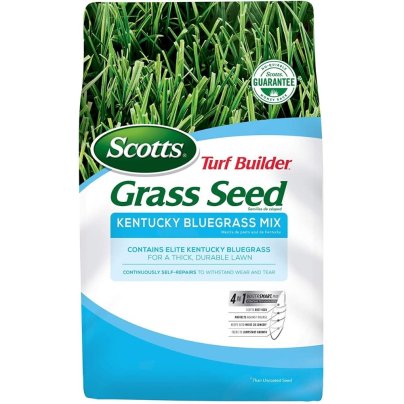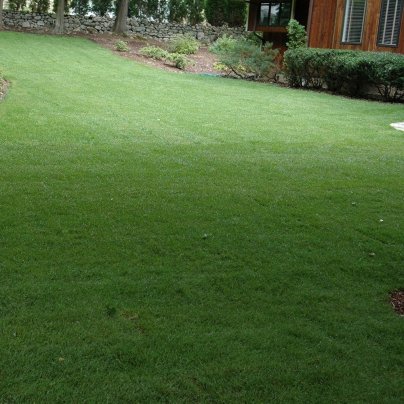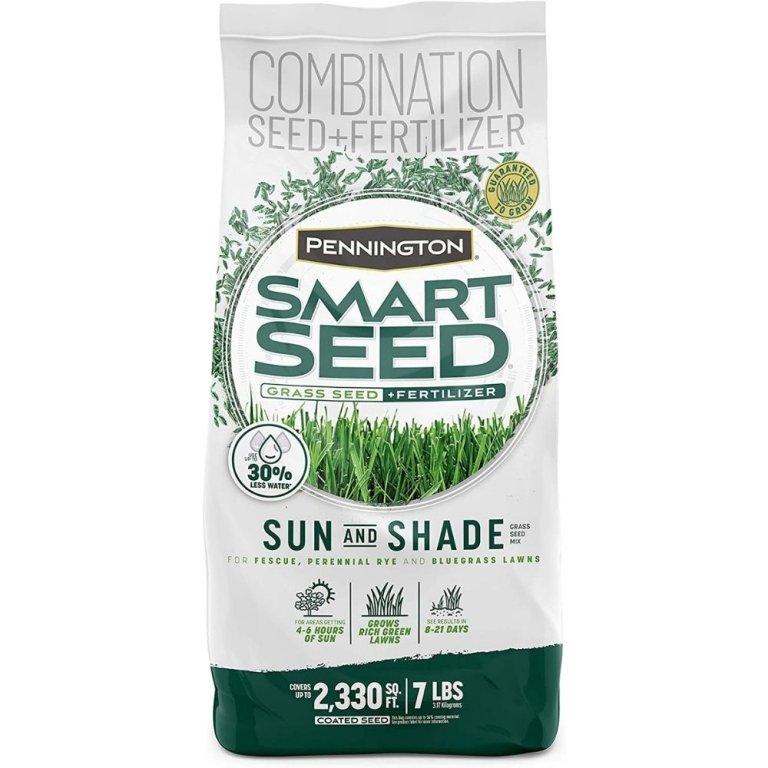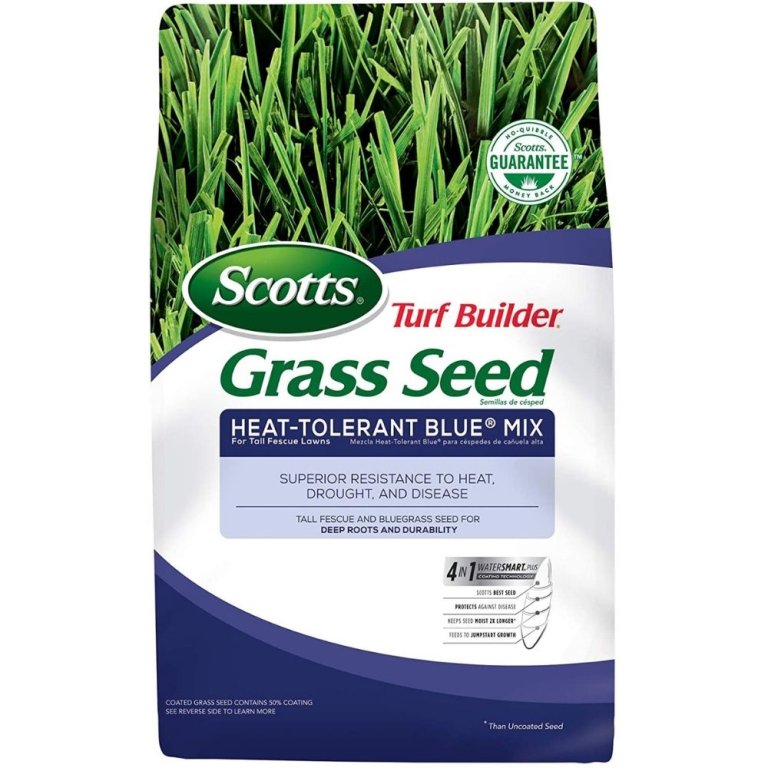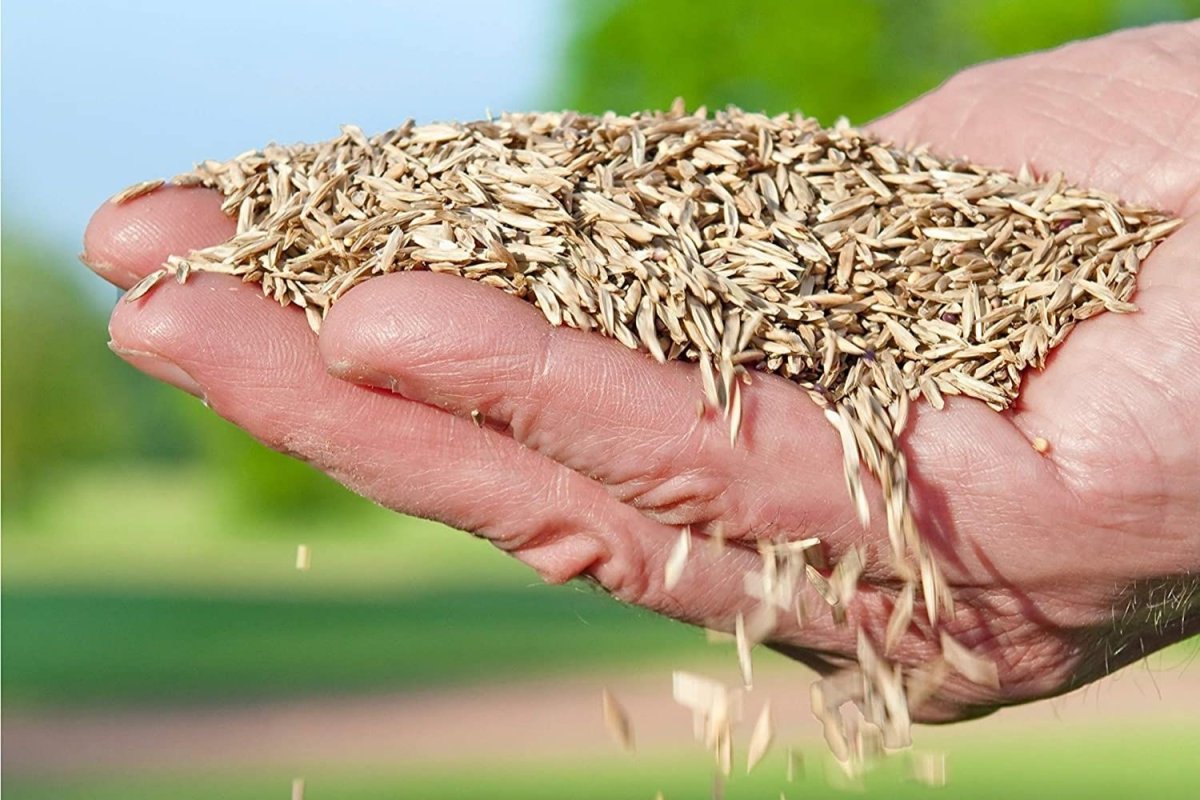
We may earn revenue from the products available on this page and participate in affiliate programs. Learn More ›
Kentucky bluegrass—prized for its soft, low-growing habit—is best suited to northern regions where summer temps do not exceed 75 degrees Fahrenheit, making it an optimal choice for the Northeast and northern Central regions of the United States.
This desirable grass seed spreads by rhizome to fill in bare spots, and though some choose to establish a bluegrass by laying sod, it also grows from seed. The best Kentucky bluegrass seed may come as a bluegrass-only product, or it might come blended with another type of grass seed to help the bluegrass become established. Our top recommendation is Scotts Turf Builder thanks to its dense growth, fertilizer mix, and reasonable price tag for the coverage.
Ahead, discover why this cool-season grass makes a wonderfully soft yet tough lawn, and find out why the following grass seed products are all well suited for establishing a new Kentucky bluegrass lawn or for overseeding an existing one.
- BEST OVERALL: Scotts Turf Builder Grass Seed Kentucky Bluegrass Mix
- RUNNER UP: Outsidepride Midnight Kentucky Bluegrass Seed
- BEST WITH FERTILIZER: Pennington Smart Seed Grass Seed and Fertilizer Mix
- BEST HEAT TOLERANCE: Scotts Turf Builder Grass Seed Heat-Tolerant Blue Mix
- BEST FOR LARGE LAWNS: Pendelton Turf Supply Jacklin Seed
- ALSO CONSIDER: GreenView 2829352 Kentucky Bluegrass Blend
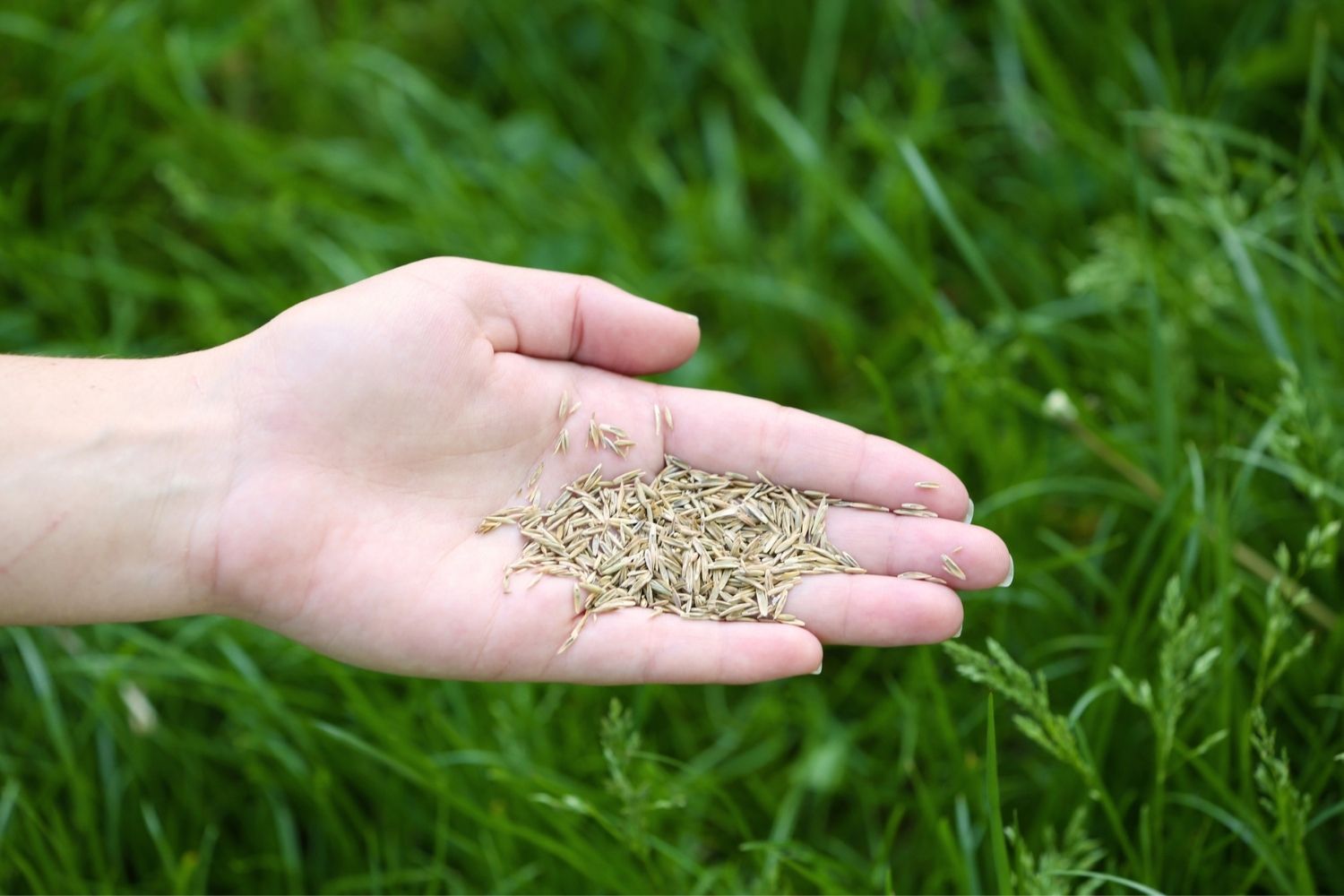
Our Top Picks
While Kentucky bluegrass is an optimal cool-season choice for northern lawns, it can be slow to establish, so consumers might want to choose a blended seed product that contains other seed varieties or one with coated seeds. As individual yards vary, so do growing needs. The following Kentucky bluegrass seed products are all well suited for establishing new lawns or overseeding existing ones.
Best Overall
Scotts Turf Builder Grass Seed Kentucky Bluegrass Mix
From Scotts, this turf-building grass seed is designed to establish healthy Kentucky bluegrass lawns. This variety produces soft, fine grass blades that grow exceptionally well in full sunlight but also can tolerate light shade. The seed also naturally resists slight drought and will withstand heavy traffic.
Scotts bluegrass seed mix features their 4-in-1 coating technology that helps keep the seeds damp during germination, protects against disease, and provides young sprouts with fertilizer to jump-start growth. This product contains only coated bluegrass seed—no other seed varieties are in the mix—and one 3-pound bag will seed up to 2,000 square feet of lawn.
Runner Up
Outsidepride Midnight Kentucky Bluegrass Seed
Those looking for a dark green lawn with a hint of blue need look no further. This noncoated bluegrass variety was developed in Oregon for its rich color, soft and compact growth habit, and ability to stand up to heavy foot traffic. This is a bluegrass-only seed, but users can mix it with either red fescue or perennial ryegrass seeds if they desire an additional seed variety.
Midnight, like all bluegrasses, thrives in cool climates but will tolerate moderate heat. Its short growth pattern means less mowing to keep it looking good, and Midnight grows well in both sandy and clay-based soils, as well as loamy soils. It comes in a 5-pound bag, and the manufacturer recommends using 3 to 5 pounds per 1,000 square feet.
Best with Fertilizer
Pennington Smart Seed Grass Seed and Fertilizer Mix
Pennington’s seed mix covers all bases for both sunny and shady spots in northern lawns with a premium combination of Kentucky bluegrass, fescue, and perennial rye seeds. The grass seeds are coated to help retain moisture and provide nutrients to the sprouts as soon as they germinate for robust, healthy growth.
This Pennington product offers an ultimate blend for growers wanting the lush look and feel of bluegrass with the early germination and shade tolerance of fescue and ryegrass. A single bag weighs 20 pounds and is suitable for seeding up to 5,000 square feet.
Best Heat Tolerance
Scotts Turf Builder Grass Seed Heat-Tolerant Blue Mix
With a combination of fescue and bluegrass seeds, this heat-tolerant mix can fill lawns in regions that see summer temperatures around the 80-degree mark. The seeds’ coating absorbs and retains moisture, so the seeds won’t dry out before germination. It also provides nutrients to young sprouts and includes antifungal ingredients to reduce the risk of fungal disease.
Scotts produces a deep green lawn that’s lush and will withstand foot traffic, and it’s highly drought resistant for a whole-yard seed product that doesn’t require the application of any other treatments when seeding. A 20-pound bag seeds up to 5,000 square feet.
Best for Large Lawns
Pendelton Turf Supply Jacklin Seed
This 100 percent bluegrass seed product comes in a 50-pound bag—enough for a large lawn of up to 20,000 square feet. It provides durability for heavy foot traffic and has been developed to resist diseases. The uncoated seeds are a mix of various low-growing bluegrass varieties to offer the grower a well-rounded lawn that will tolerate moderate drought and light shade.
The recommended application rate is just 2.5 pounds per 1,000 square feet, so this product goes a long way. The manufacturer suggests using a seed-starting fertilizer when establishing a new lawn.
Also Consider
Greenview 2829352 Kentucky Bluegrass Blend Grass Seed
It doesn’t have to cost a fortune to establish a bluegrass lawn. Greenview’s high-quality bluegrass seeds at an affordable price point. The product is uncoated and comes in a 3-pound bag, suitable for seeding a new lawn up to 1,500 square feet or overseeding an existing lawn of up to 3,000 square feet.
This is a bluegrass-only product—no other varieties are included. The manufacturer recommends seeding new lawns in conjunction with the application of GreenView Seed Success (sold separately), which is a proprietary blend of biodegradable mulch pellets designed to protect the bluegrass seeds and offer nutrition once they germinate.
What to Consider When Choosing the Best Kentucky Bluegrass Seed
While Kentucky bluegrass is a popular lawn variety, it isn’t for everyone. Testing and hybridizing have helped create several varieties that are more heat tolerant. However, bluegrass still isn’t suitable for areas that see hot, dry summers since these conditions will weaken the grass and make it more prone to disease.
When shopping for bluegrass seed, some factors come into play, including knowing how much seed is required to cover a specific area and how well a particular type of seed germinates. Growers also will need to consider whether they want a blended bluegrass product containing a different grass seed to protect the bluegrass while it’s getting a foothold.
Product Contents
Several Kentucky bluegrass seed products contain additional grass seed varieties, such as perennial ryegrass or tall fescue, which are quick to germinate. As a result, the roots of the quicker grasses help stabilize the soil. This reduces the risk of erosion from heavy rains, so slow-to-germinate bluegrass seeds are less likely to wash away. Both ryegrass and fescue can sprout within 5 to 7 days, while it takes Kentucky bluegrass 10 to 21 days to germinate.
Some bluegrass seed products also feature coated seeds. The coating might contain either fertilizer or a moisture-retaining agent. Kentucky bluegrass seeds should remain moist from the time they’re planted to ensure successful germination. A moisture-retaining coating can help keep them viable. Once they sprout, if the seed coating also contains fertilizer, it will boost growth to get the little sprouts off to a healthy start.
Best Germination Results
For optimal germination, bluegrass seeds should be planted approximately 1/4 to 1/2 inch deep in early spring or late fall. Late fall may provide higher germination rates since the young blades of grass will not experience the heat of summer before they mature. Bluegrass isn’t the fastest-growing grass, but it continues spreading beneath the soil to form a dense, soft turf once it’s established.
For the best long-term results, amend the soil to suit bluegrass before planting the seeds. This involves having the soil tested by a local county extension agency. Kentucky bluegrass grows best in soil with a pH between 6 and 7. If the soil pH tests too high or low, the extension agency can recommend products to amend the pH before planting.
Coverage
In general, it takes about 3 pounds of bluegrass seed to cover 1,000 square feet of new lawn. Still, coverage will vary from product to product based on whether the bag contains only bluegrass seeds or whether the seeds come mixed with fescue or ryegrass as a cover crop. Coverage will also vary for coated seeds, which weigh more than uncoated seeds.
Overseeding an existing lawn requires less seed, approximately 1.5 pounds per 1,000 square feet. Before ordering a bluegrass seed product, measure the property to determine how much seed to buy. Then, read the product’s suggested coverage rates (some varieties have higher germination rates, which require less seed per square foot).
Additional Features and Characteristics
Once established in an optimal climate, Kentucky bluegrass will develop a deep rich shade of emerald green that may feature a slight hint of blue. A healthy bluegrass lawn is also a tough lawn—making it well suited for activities and foot traffic.
While Kentucky bluegrass loves cool weather, it doesn’t care for deep shade—it will only tolerate light shade in most situations. Bluegrass is very winter-tolerant, making it among the best seed choices for northern lawns where temps can drop well below zero in the winter.
Seed producers have developed a variety of Kentucky bluegrass types designed to tolerate certain conditions better than others so that consumers can find drought-tolerant, shade-tolerant, and even a few heat-tolerant varieties.
Tips for Buying and Using Kentucky Bluegrass Seed
Select a bluegrass seed variety based on the yard’s properties—soil, location, and climate. Choose a variety that addresses any special needs, such as shady spots or temps in summer that exceed 75 degrees—and how often they soar higher.
- Prepare the yard by loosening the soil to a depth of about 3 inches—tilling to break up clods. Multiple tillings may be necessary.
- Use a drop spreader or—better yet—a seed drill, often available to rent from an equipment rental store. A drill will deposit the seeds at the correct depth beneath the soil surface. If using a drop spreader, cover the seeds (by raking) to a depth of 1/4 to 1/2 inch deep.
- Keep the soil moist but not soggy until the bluegrass seeds sprout, then water frequently for the next few weeks to help them get established. Once established, bluegrass lawns need an average of 1 inch of water per week.
FAQs
Kentucky bluegrass is one of the most desirable grass species for northern regions where daytime temps rarely exceed 75 degrees Fahrenheit. It’s a little finicky, though, so understanding this grass species will help consumers make a suitable choice.
Q. How late can I plant Kentucky bluegrass?
Fall temperatures vary by region, but in many areas, you can plant bluegrass as late as November. The best rule of thumb is to plant when soil temperatures are between 50 and 60 degrees Fahrenheit.
Q. Will Kentucky bluegrass fill in bare spots?
Yes, Kentucky bluegrass spreads by underground rhizomes, so it can cover bare patches if given time.
Q. What is the right time to plant Kentucky bluegrass?
Kentucky bluegrass can be planted either in the early spring or fall, but fall is considered optimal.
Q. Will Kentucky bluegrass choke out weeds?
If the grass is healthy, yes, it can spread and choke out weeds.
